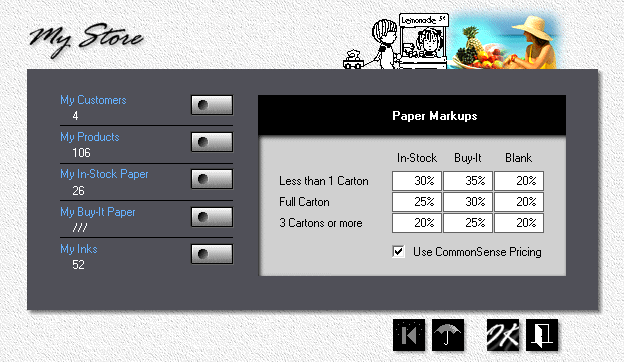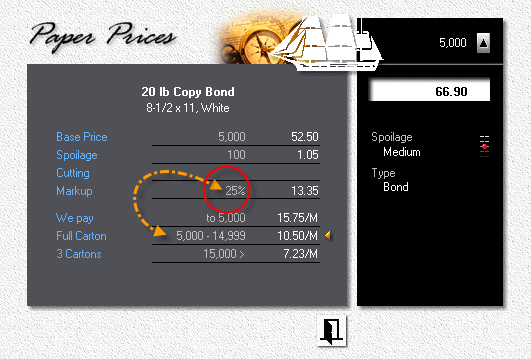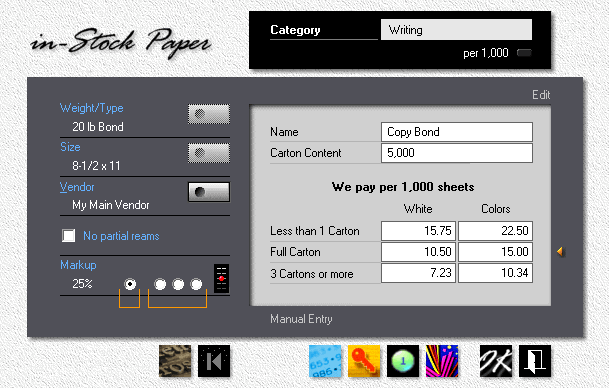Paper Markups
Overview
Setting up paper markups ought to be simple. Far too many printers forgo markups entirely and think it's Ok to sell paper at cost. That being the case, why not settle on a single markup rate and be done with it? Absolutely - no reason not to.
On second thought, better make it two rates. The best way to motivate buyers to select paper we have on the shelf is to reduce the markup on it. We definitely want to encourage that. Three rates then, one for paper we keep on hand, one for paper we have to order as needed, and a third for blank second sheets. Ok, we're good. Let's run with that.
No, wait. Shouldn't we use smaller markups on larger quantities? Good point. So nine entry boxes to fill in. Still, simple enough, all things considered.

Except, and I don't mean to throw a wrench in it, shouldn't we also have custom markups for exceptional projects? "Make 'em up as you go" rates we can apply, like, whenever? Why, yes, we should.
You can see where this is going. Our simple train has left the station. Ditching general markups altogether and relying solely on custom markups for each individual item isn't such a brilliant idea either. Who'd want to update hundreds of paper records, one at a time, when it's time for a markup makeover? Proving once again that KISS (Keeping It Simple Stupid) and functionality don't always go hand in hand.
Setting General Markups
The markup rates you enter into the nine boxes in My Store are what Morning Flight uses by default, based on paper category and quantity. If you want to use a single rate across the board, just enter identical rates in all nine boxes.
In the window below, the little gold triangle points to the quantity in use. The 25% rate is linked to the settings in My Store. Had the quantity been three cartons or more, the markup rate would have dropped to 20%.

Working with Custom Markups
Here is where it gets interesting. A little difficult to decipher maybe when you first encounter the buttons, but scratch the surface and you'll discover a mechanism that's still simple.
Worth noting is that custom markups are an option not only when you make a quote, but also when you set up or edit paper. You could, if you wanted to, give every paper item in every paper file a different markup rate. And then spend way too much time keeping track of it. Seriously - don't even think about it!

Take a peek at the four radio buttons. You'll note they've been graphically separated into two groups. The first button is dynamic, linked to the markup rates set in My Store. The next three are static, totally independent, producing fixed markup rates not linked to anything. Not to quantity, not to category, not to My Store. When the markup says 10%, ten percent is what Morning Flight adds to our cost. Values range from 0% - 20%, 25% - 45%, and 50% - 150%.
Let's revisit the first button. Here you can fine-tune the markup rate coming in from My Store by left-clicking or right-clicking the black slider. Each click increases or lowers the markup by one percentage point. The effective rate will vary, depending on the quantity in use.
In the example below, the quote calls for a full carton. The slider is set at its lowest point, so the markup drops two percentage points, lowering it from 25% to 23%.

So to recap, the first button offers a two-point adjustment, up or down, for each of the nine markup fields in My Store. Because the slider gets its mid-range value from My Store, when you adjust a general markup rate in My Store, the custom rate rides along with it.
The next three buttons serve up a flat, permanent markup rate, regardless of the quantity or the type of paper. What you see is what you get. Down to, and including, zero - no profit of any kind. Sometimes, in the real world, often less. But you already knew that!
See also
